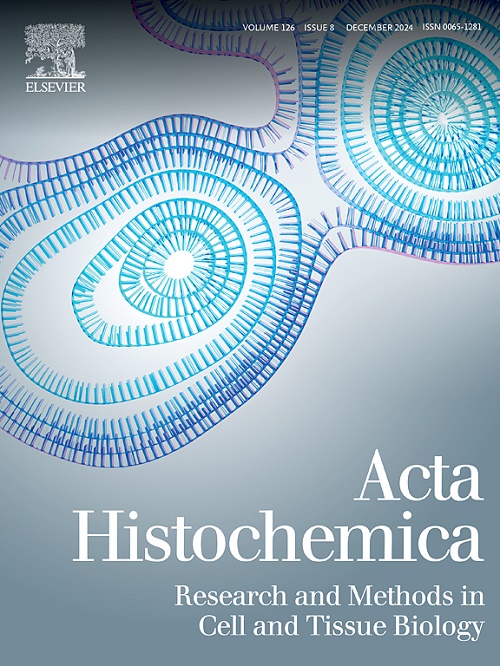HSPB1通过抑制PANoptosis促进胃癌进展
IF 2.4
4区 生物学
Q4 CELL BIOLOGY
引用次数: 0
摘要
胃癌(GC)仍然是全球癌症相关死亡的主要原因,由促进肿瘤进展和治疗耐药的分子机制驱动。PANoptosis是一种包括凋亡、坏死和焦亡在内的综合性程序性细胞死亡途径,已成为肿瘤发生的关键调节因子,但其在GC中的调节作用尚不清楚。本研究旨在探讨热休克蛋白β -1 (HSPB1)在调节PANoptosis中的作用及其对GC进展的影响,并假设HSPB1过表达抑制PANoptosis从而增强肿瘤恶性。我们采用了一种综合方法,将GEO (GSE54129)、TCGA和GSE15460数据集的生物信息学分析与实验验证相结合。通过qPCR、Western blot和免疫组化检测40对GC和正常组织以及多个GC细胞系(AGS、MKN-45、NCI-N87、HGC-27、SNU-1)中HSPB1的表达。通过在NCI-N87和AGS细胞中过表达或沉默HSPB1,然后进行增殖、集落形成、迁移和凋亡实验,探索其功能作用。利用转染shhspb1细胞的裸鼠异种移植模型评估体内效应,通过Western blot、IHC和TUNEL分析肿瘤生长和PANoptosis标志物(P-MLKL、RIPK3、Cleaved Caspase-1、NLRP3、Cleaved Caspase-3)。生物信息学显示HSPB1是panopsis相关的预后生物标志物,在GC组织中表达升高与生存不良相关。实验证实HSPB1在GC组织和细胞系中过表达。HSPB1过表达增强细胞增殖、侵袭和迁移,同时通过下调PANoptosis标志物抑制细胞凋亡。相反,HSPB1沉默抑制这些致癌性状并激活PANoptosis,显著降低肿瘤在体内的生长,并伴有PANoptosis相关蛋白上调和细胞凋亡增加。HSPB1通过抑制PANoptosis促进GC进展,从而提高肿瘤存活和侵袭性,而其沉默激活这些细胞死亡途径以抑制肿瘤发生。这些发现表明HSPB1是胃癌PANoptosis的关键调节因子和潜在的治疗靶点,为克服耐药性和改善患者预后提供了新的途径。本文章由计算机程序翻译,如有差异,请以英文原文为准。
HSPB1 promotes gastric cancer progression by suppressing PANoptosis
Gastric cancer (GC) remains a leading cause of cancer-related mortality worldwide, driven by molecular mechanisms that promote tumor progression and therapeutic resistance. PANoptosis, an integrated programmed cell death pathway involving apoptosis, necroptosis, and pyroptosis, has emerged as a key regulator of tumorigenesis, yet its modulation in GC is poorly understood. This study aimed to investigate the role of heat shock protein beta-1 (HSPB1) in regulating PANoptosis and its impact on GC progression, hypothesizing that HSPB1 overexpression suppresses PANoptosis to enhance tumor malignancy. We employed an integrative approach combining bioinformatics analysis of GEO (GSE54129), TCGA, and GSE15460 datasets with experimental validations. HSPB1 expression was assessed in 40 paired GC and normal tissues and multiple GC cell lines (AGS, MKN-45, NCI-N87, HGC-27, SNU-1) via qPCR, Western blot, and immunohistochemistry. Functional roles were explored by overexpressing or silencing HSPB1 in NCI-N87 and AGS cells, followed by proliferation, colony formation, migration, and apoptosis assays. In vivo effects were evaluated using a nude mouse xenograft model with shHSPB1-transfected cells, analyzing tumor growth and PANoptosis markers (P-MLKL, RIPK3, Cleaved Caspase-1, NLRP3, Cleaved Caspase-3) via Western blot, IHC, and TUNEL assays. Bioinformatics revealed HSPB1 as a PANoptosis-related prognostic biomarker, with elevated expression in GC tissues correlating with poor survival. Experimental validation confirmed HSPB1 overexpression in GC tissues and cell lines. HSPB1 overexpression enhanced proliferation, invasion, and migration while suppressing apoptosis by downregulating PANoptosis markers. Conversely, HSPB1 silencing inhibited these oncogenic traits and activated PANoptosis, significantly reducing tumor growth in vivo, accompanied by upregulated PANoptosis-related proteins and increased apoptosis.HSPB1 promotes GC progression by inhibiting PANoptosis, thereby enhancing tumor survival and aggressiveness, whereas its silencing activates these cell death pathways to suppress tumorigenesis. These findings establish HSPB1 as a critical regulator of PANoptosis in GC and a potential therapeutic target, offering new avenues for overcoming resistance and improving patient outcomes.
求助全文
通过发布文献求助,成功后即可免费获取论文全文。
去求助
来源期刊

Acta histochemica
生物-细胞生物学
CiteScore
4.60
自引率
4.00%
发文量
107
审稿时长
23 days
期刊介绍:
Acta histochemica, a journal of structural biochemistry of cells and tissues, publishes original research articles, short communications, reviews, letters to the editor, meeting reports and abstracts of meetings. The aim of the journal is to provide a forum for the cytochemical and histochemical research community in the life sciences, including cell biology, biotechnology, neurobiology, immunobiology, pathology, pharmacology, botany, zoology and environmental and toxicological research. The journal focuses on new developments in cytochemistry and histochemistry and their applications. Manuscripts reporting on studies of living cells and tissues are particularly welcome. Understanding the complexity of cells and tissues, i.e. their biocomplexity and biodiversity, is a major goal of the journal and reports on this topic are especially encouraged. Original research articles, short communications and reviews that report on new developments in cytochemistry and histochemistry are welcomed, especially when molecular biology is combined with the use of advanced microscopical techniques including image analysis and cytometry. Letters to the editor should comment or interpret previously published articles in the journal to trigger scientific discussions. Meeting reports are considered to be very important publications in the journal because they are excellent opportunities to present state-of-the-art overviews of fields in research where the developments are fast and hard to follow. Authors of meeting reports should consult the editors before writing a report. The editorial policy of the editors and the editorial board is rapid publication. Once a manuscript is received by one of the editors, an editorial decision about acceptance, revision or rejection will be taken within a month. It is the aim of the publishers to have a manuscript published within three months after the manuscript has been accepted
 求助内容:
求助内容: 应助结果提醒方式:
应助结果提醒方式:


